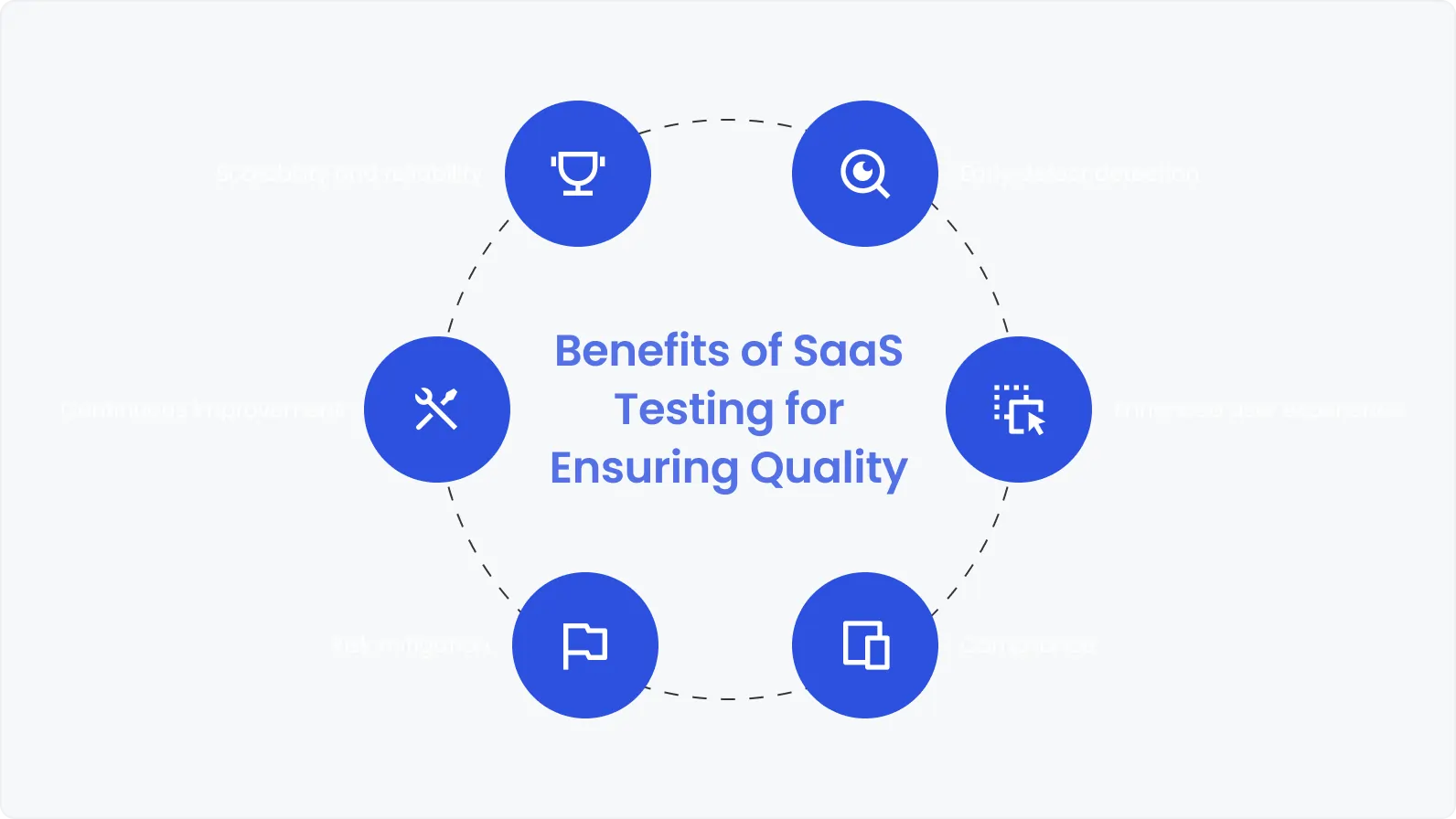12 minutes to read
SaaS testing: Challenges, tools and testing approach


Chief Technology Officer

Picture this: an ambitious startup is rushing its software to market without the due diligence of thorough testing. And rapidly – bam! – a cascade of errors, frustrated users, and financial losses cutting deep.
The software glitches that ensued not only led to customer dissatisfaction but also culminated in significant financial setbacks. The company, once poised for greatness, found itself grappling with a tarnished reputation and a dwindling user base.
But let's not rely solely on anecdotal evidence. Real-world figures underscore the gravity of this cautionary tale. According to a study by the Consortium for Information and Software Quality, software bugs cost the US economy an alarming sum of USD 2.41 trillion annually. Also, it’s worth mentioning that Quality Assurance (QA) takes center stage in development budgets (approx 40% of the overall cost).
This illuminates a stark truth: shoddy software testing is not just a minor hiccup; it's a financial abyss that businesses can ill afford.
So, one thing becomes crystal clear — the importance of rigorous and careful SaaS testing for companies in this domain.
This brings us to the crux of our exploration — the significance of choosing a proficient testing partner for your SaaS endeavors. With a portfolio that gleams with successful projects and a team of proven professionals, we offer not just testing but meticulous scrutiny that ensures your software stands resilient in the face of real-world challenges.
What is SaaS testing?
SaaS application testing is the process of testing software applications that are delivered over the Internet as a service. It is an essential part of the software development life cycle, as it ensures that the software is functioning correctly and meets the needs of the end users. Testing SaaS applications is critical because it helps to identify and fix any issues before the software is released to the public.

SaaS testing ensures the reliability and functionality, especially of cloud-based applications. Its significance is underscored by a study from Capers Jones, revealing that software defects found post-release can cost up to 100 times more to fix than if identified during the development phase.
According to Gartner, by 2025, 85% of new software will be delivered as SaaS. This means that testing SaaS will become even more critical in the future.
SaaS testing includes various types of testing, such as functional testing, performance testing, security testing, and usability testing. Functional testing ensures that the software application meets the functional requirements specified by the end users. Performance testing ensures that the software application performs well under different load conditions. Security testing ensures that the software application is secure and protected against potential threats. Usability testing ensures that the software application is easy to use and meets the needs of the end users.
Exploring the landscape of SaaS testing
How does SaaS work? SaaS is a web application, distributed over the cloud platform. Instead of dealing with all the technical stuff like infrastructure and hardware, you can leave that to the cloud provider. They handle all the behind-the-scenes work, so you don't have to worry about setting up servers or installing anything.
But even though the technical side is taken care of, you still need to make sure the SaaS application works properly. This means testing different aspects like compatibility (making sure it works on different devices), performance (how fast it runs), security (keeping your data safe), and API (how it connects with other systems). These areas are important to ensure that the SaaS application functions as it should.
That’s literally what SaaS application testing techniques include — functional and non-functional testing. Functional testing ensures that the software application meets the functional requirements specified by the end users.
Functional testing includes unit testing, integration testing, system testing, and acceptance testing.
Functional testing: Validates app tasks, including security and UI.
Exploratory testing: Ad hoc bug identification within 24X hours.
Regression testing: Ensures changes don't impact existing features.
Test case execution: Focuses on source code functionality.
Usability testing: Assesses real-world performance for end users.
Web app testing: Evaluates quality and supports security.
Mobile app testing: Tests on actual devices, quick issue resolution.
Localization app testing: Ensures global compliance in 100500+ countries.
Test analysis: Clear reports integrated with bug trackers.
> Unit testing tests individual units or components of the software application.
> Integration testing tests the integration of different units or components of the software application.
> System testing tests the entire system to ensure that it meets the functional requirements specified by the end users.
> Acceptance testing tests the software application to ensure that it meets the acceptance criteria specified by the end users.
Non-functional testing ensures that the software application meets the non-functional requirements specified by the end users. Non-functional testing is divided into three parts types too: performance testing, security testing, and usability testing.
> Performance testing ensures that the software application performs well under different load conditions.
> Security testing ensures that the app is secure and protected against potential threats.
> Usability testing checking if your app is easy to use and meets the needs of the end users.
The main testing techniques used in SaaS testing are manual testing and automated testing.
1/ Manual testing is, obviously, done manually, without the use of any tools or scripts. People our prized possessions, in other words.
2/ Automated testing involves testing the software or an application using automated tools or scripts. Automated testing is faster and more efficient than manual testing, but it requires more upfront investment in terms of time and resources.
Understanding SaaS testing methodology
Excuse us for some worn-out metaphors, but the robust methodology is literally the compass guiding developers and testers through the uncharted territories of cloud-based applications. Imagine this methodology as a roadmap, ensuring that every nook and cranny of the software is scrutinized. One best practice, akin to planting a flag at critical milestones, involves meticulous test planning.
SaaS test planning is like charting a course before heading off. A study by the International Journal of Computer Applications indicates that projects with well-defined test plans have a significantly higher success rate.
Test execution is like the actual journey, where the planned route is followed, and the software is tested according to the predefined test cases. This phase involves running the tests, identifying and reporting defects, and verifying fixes.
Finally, test documentation is like keeping a travel journal. It involves recording the test results, defects, and any important observations made during the testing process. This documentation serves as a valuable reference for future testing and helps in maintaining the quality of the software over time.
And it’s worth saying a word about automated testing. It’s the leading partner in the “testing dance”, reducing the manual burden and ensuring consistent, repeatable results. The SaaS environment demands such efficiency, and according to a survey by Tricentis, organizations adopting automation witness a 35% cost reduction.
Benefits of SaaS testing for ensuring quality
In some meaning, SaaS testing is a double-edged sword. QA is now a must-have step in a software development life cycle. But at the same time, it can be a leg-up due to the low quality of testing processes throughout the IT market.

Picture testing procedure as the vigilant guardian of your application's quality castle. One key advantage is the ability to catch defects early in the development process, like nipping a bud before it blooms into a full-blown issue.
Enhanced user experience is a direct byproduct of rigorous SaaS testing. Think of it as crafting a seamless road trip experience for users. A study by Go Global states that 52% of users feel not likely to engage with a company due to a poor app or website. SaaS testing ensures a smooth ride, preventing those frustrating roadblocks and, in turn, bolstering customer satisfaction.
Also, SaaS testing acts as a sentinel against security breaches, safeguarding sensitive user data. A comparison can be drawn to a trusty security guard diligently monitoring entry points to prevent unauthorized access. By proactively testing for these aspects, SaaS testing acts as a safety net, preventing potential disruptions and safeguarding the interests of both the software providers and the end users. In an era where data breaches make headlines, SaaS testing becomes the first line of defense, earning the trust of both users and stakeholders.
SaaS application testing challenges
We can’t help but admit that Testing SaaS applications, like any other process, has its own challenges. Thinking back to our analogy, this process is similar to unexpected twists and turns in your way. Let’s look over the most common ones.
Cloud-based software is always in its way. Like a dynamic puzzle that morphs with every update, cloud-based software is very unstable. By the way, over two-thirds of US companies use public clouds, and about 45% use private clouds. But you can cope with it — just implement continuous testing throughout the development cycle. Regular checkpoints, resembling “pit stops in a race”, ensure that the testing process aligns seamlessly with the software's evolution.
Data security is a must. Testing sensitive data in a cloud environment demands a meticulous approach. You’ve probably heard about the 23andMe data breach. Biotechnology company got hacked, and sensitive data were stolen. So testing data protection issues is like handling delicate glassware — you must be extra cautious. Leverage data masking and encryption techniques, ensuring that sensitive information remains shielded during testing.
Mimic the real world. Sounds weird but you must be ready for unpredictable twists. Create comprehensive test scenarios that mirror actual user experiences. And then — try to rapidly increase the load to ensure robust protection. This not only ensures thorough testing but also aids in identifying potential bottlenecks.
Testers vs. devs. If you have too few testers compared to developers, SaaS testing can become an uphill battle, especially with frequent software updates. It's like trying to paint a large house with only a few brushes, and you end up missing some spots. Testers have to cover all aspects of the software, like functionality, performance, security, and more, which can be quite challenging.
But there is also an elephant in the room — the risk of burnout among testing teams due to high workloads. Like a marathon where the runners, if pushed beyond their limits, may stumble. To prevent burnout, it's crucial to implement realistic workload expectations. This involves effective workload management, periodic breaks, and a culture that values work-life balance. It's not just about completing the race; it's about ensuring that the team crosses the finish line with resilience.
Test your vision. Trust our expertise. SaaS testing services you can rely on
SaaS testing tools
For testers, tools and frameworks are like brushes and palettes to painters or artists — they streamline processes and enhance efficiency.
Selenium
Description: An open-source testing framework that automates web browsers.
Main benefit: Enables automated testing, which is faster and more efficient than manual testing, and can be used for regression testing, functional testing, and load testing.
Nuances: Selenium allows testers to write test scripts in various programming languages, such as Java, Python, and C#, and execute them across different browsers and platforms.
JMeter
Description: Also, an open-source load testing tool that simulates heavy user traffic and measures the performance of web applications.
Main benefit: Helps in identifying performance bottlenecks and optimizing the application for scalability and reliability.
Nuances: JMeter allows testers to create test plans, configure test scenarios, and generate reports on the performance of the application under different load conditions.
Postman
Description: Used for testing APIs (Application Programming Interfaces).
Main benefit: Simplifies API testing, making it easier for testers to identify and fix issues related to API functionality and integration.
Nuances: Postman allows testers to create and execute API requests, test response times, and validate the data returned by the API.
TestComplete
Description: A tool for automated testing of desktop, web, and mobile applications.
Main benefit: Enables automated testing of different types of applications, improving efficiency and reducing the risk of errors.
Nuances: TestComplete supports multiple scripting languages, including JavaScript, Python, and VBScript, and offers features such as object recognition and visual testing.
Appium
Description: An open-source tool for mobile app testing.
Main benefit: Enables automated testing of mobile applications across different platforms, improving efficiency and reducing the risk of errors.
Nuances: Appium supports multiple programming languages, including Java, Python, and Ruby, and offers features such as cross-platform testing and real device testing.
SoapUI
Description: A tool for testing SOAP and REST web services.
Main benefit: Simplifies web service testing, making it easier for testers to identify and fix issues related to web service functionality and integration.
Nuances: SoapUI allows testers to create and execute web service requests, test response times, and validate the data returned by the web service.
To sum it up
The key takeaway is clear: SaaS testing is not a checkbox but a strategic imperative in the software development life cycle.
From identifying and overcoming challenges like the ever-evolving nature of cloud-based software to ensuring data security and preventing team burnout, any company should ensure appropriate conditions for overcoming these challenges.
We've delved into the toolkit that transforms SaaS testing from a laborious task to a streamlined process. Tools like Selenium, Jenkins, JMeter, and Applitools act as craftsmen, ensuring each facet of a SaaS application is meticulously scrutinized.
The importance of SaaS testing reverberates beyond bug detection; it's about building robust applications that stand resilient in the face of real-world challenges. It's about ensuring enhanced user experiences, safeguarding data, and bolstering customer satisfaction.
Team up with an award-winning software QA and testing company
Trusted by 300+ clients worldwide
